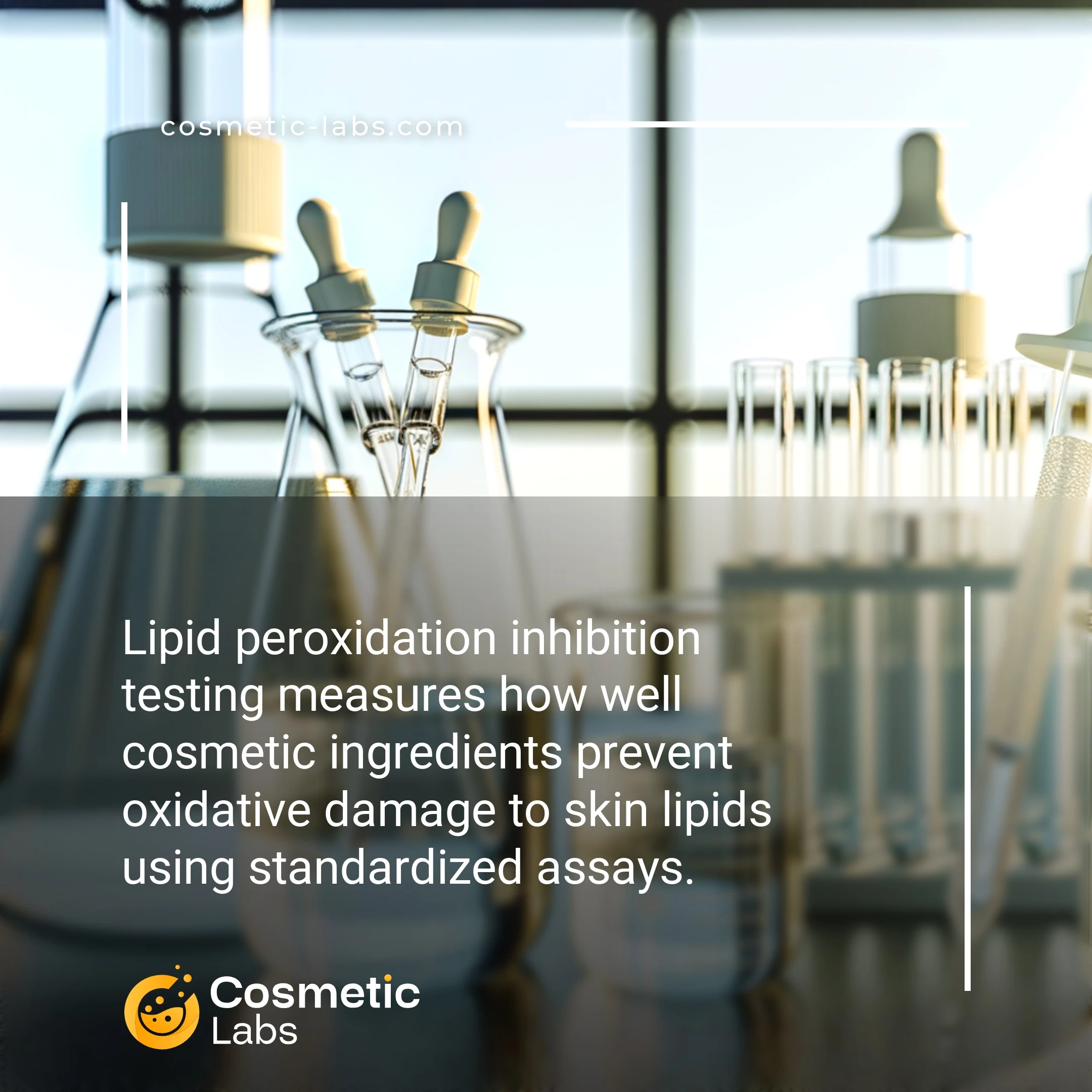Lipid Peroxidation Testing Services For Beauty Brands

What is Lipid peroxidation inhibition testing?
Lipid peroxidation inhibition testing is a laboratory analysis that measures how well cosmetic ingredients and formulations prevent oxidative damage to skin lipids. Labs use standardized assays like the TBARS method to quantify malondialdehyde levels, showing whether your antioxidant actives actually protect cellular membranes from free radical damage. This testing helps brands validate anti-aging claims and optimize formulations with proven protective benefits.
Why do you need this service?
Beauty brands use lipid peroxidation inhibition testing to validate anti-aging claims for serums and moisturizers containing antioxidants like vitamin C, retinol, and botanical extracts. Labs measure how effectively your formulations prevent cellular membrane damage, providing quantifiable data for marketing claims and regulatory submissions while optimizing ingredient concentrations during product development.
Who provides Lipid peroxidation inhibition testing services?
All cosmetic labs providing Lipid peroxidation inhibition testing services
There is no company providing these services at the moment.
Lipid Peroxidation Inhibition Testing Services
Lipid peroxidation inhibition testing measures how well your cosmetic ingredients and formulations protect against oxidative damage to cellular membranes. This testing builds on oxidative stress preclinical efficacy protocols to evaluate your product’s ability to prevent lipid degradation, a key factor in skin aging and damage.
Laboratory Testing Methods
Partner labs use standardized assays to measure antioxidant capacity and membrane protection. The thiobarbituric acid reactive substances (TBARS) assay quantifies malondialdehyde levels, while the ferric reducing antioxidant power (FRAP) test evaluates total antioxidant strength.
Testing protocols include:
- Cell membrane stability assessment
- Free radical scavenging activity measurement
- Lipid oxidation byproduct analysis
- Comparative efficacy studies against known antioxidants
Applications for Product Development
These tests help you validate anti-aging claims and optimize formulations with ingredients like vitamin E, resveratrol, or plant extracts. Results support marketing claims about skin protection and provide data for regulatory submissions.
Labs typically deliver results within 2-3 weeks, including detailed reports with statistical analysis and recommendations for formulation improvements. This data proves particularly valuable for serums, moisturizers, and sun care products targeting mature skin concerns.
Ready to validate your product’s protective benefits? Connect with experienced cosmetic testing laboratories through our platform to discuss your specific testing requirements.
Practical Applications of Lipid Peroxidation Inhibition Testing
Cosmetic labs use lipid peroxidation inhibition testing applications to validate antioxidant claims and optimize formulations for skin barrier protection across multiple product categories.
Anti-Aging Product Development
Labs test serums, creams, and treatments containing vitamin C, retinoids, and botanical extracts to measure their ability to prevent lipid membrane damage. The thiobarbituric acid reactive substances (TBARS) assay quantifies malondialdehyde levels, providing IC50 values that determine antioxidant potency. Results directly support marketing claims about wrinkle reduction and skin protection.
Testing protocols typically require 72-hour incubation periods with UV exposure to simulate environmental stressors. Labs measure oxidative markers before and after treatment to establish protection percentages ranging from 15-85% depending on active ingredient concentration.
Sunscreen and Protective Formulations
Laboratories evaluate broad-spectrum sunscreens and daily moisturizers to assess their ability to prevent UV-induced lipid oxidation in skin cell cultures. The ferric reducing antioxidant power (FRAP) test measures electron-donating capacity, while the DPPH radical scavenging assay determines free radical neutralization rates.
Testing data helps formulators optimize zinc oxide and titanium dioxide concentrations alongside chemical filters. Protection efficacy measurements range from 20-90% inhibition, directly correlating with SPF values and photostability under controlled light exposure conditions.
| Testing Method | Measurement | Typical Results | Application |
|---|---|---|---|
| TBARS Assay | Malondialdehyde levels | 15-85% inhibition | Anti-aging serums |
| FRAP Test | Electron-donating capacity | 100-2000 μmol/L | Antioxidant creams |
| DPPH Assay | Free radical scavenging | 20-90% inhibition | Protective formulations |
Ready to validate your antioxidant formulations? Connect with experienced cosmetic labs on our platform to access specialized lipid peroxidation testing services and accelerate your product development timeline.
